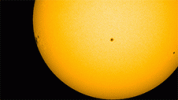
A gigantic sunspot – almost 80,000 miles across --can be seen on the lower center of the sun in this image from NASA’s Solar Dynamic Observatory captured on Oct. 23, 2014. This active region is the largest of the current
solar cycle
On Oct. 18, 2014, a sunspot rotated over the left side of the sun, and soon grew to be the largest active region seen in the current solar cycle, which began in 2008. Currently, the sunspot is almost 80,000 miles across -- ten Earth's could be laid across its diameter.
The largest sunspot of the current solar cycle rotated into view on Oct. 18, 2014. It is seen here as captured by the Helioseismic Magnetic Imager on NASA's SDO.
Sunspots point to relatively cooler areas on the sun with intense and complex magnetic fields poking out through the sun's surface. Such areas can be the source of solar eruptions such as flares or coronal mass ejections. So far, this active region – labeled AR 12192 -- has produced several significant solar
flares: an X-class flare on Oct. 19, an M-class flare on Oct. 21, and an X-class flare on Oct. 22, 2014. The largest sunspot on record occurred in 1947 and was almost three times as large as the current one.
Active regions are more common at the moment as we are in what's called solar maximum, which is the peak of the sun's activity, occurring approximately every 11 years.

http://http://www.nasa.gov/content/goddard/sdo-observes-largest-sunspot-of-the-solar-cycle/
all credit for this article goes to nasa.gov
thanks for reading fireblade.
